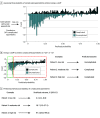Development and Validation of the Scoring System of Appendicitis Severity 2.0
- PMID: 38536188
- PMCID: PMC10974687
- DOI: 10.1001/jamasurg.2024.0235
Development and Validation of the Scoring System of Appendicitis Severity 2.0
Abstract
Importance: When considering nonoperative treatment in a patient with acute appendicitis, it is crucial to accurately rule out complicated appendicitis. The Atema score, also referred to as the Scoring System of Appendicitis Severity (SAS), has been designed to differentiate between uncomplicated and complicated appendicitis but has not been prospectively externally validated.
Objective: To externally validate the SAS and, in case of failure, to develop an improved SAS (2.0) for estimating the probability of complicated appendicitis.
Design, setting, and participants: This prospective study included adult patients who underwent operations for suspected acute appendicitis at 11 hospitals in the Netherlands between January 2020 and August 2021.
Main outcomes and measures: Appendicitis severity was predicted according to the SAS in 795 patients and its sensitivity and negative predictive value (NPV) for complicated appendicitis were calculated. Since the predefined targets of 95% for both were not met, the SAS 2.0 was developed using the same cohort. This clinical prediction model was developed with multivariable regression using clinical, biochemical, and imaging findings. The SAS 2.0 was externally validated in a temporal validation cohort consisting of 565 patients.
Results: In total, 1360 patients were included, 463 of whom (34.5%) had complicated appendicitis. Validation of the SAS resulted in a sensitivity of 83.6% (95% CI, 78.8-87.6) and an NPV of 85.0% (95% CI, 80.6-88.8), meaning that the predefined targets were not achieved. Therefore, the SAS 2.0 was developed, internally validated (C statistic, 0.87; 95% CI, 0.84-0.89), and subsequently externally validated (C statistic, 0.86; 95% CI, 0.82-0.89). The SAS 2.0 was designed to calculate a patient's individual probability of having complicated appendicitis along with a 95% CI.
Conclusions and relevance: In this study, external validation of the SAS fell short in accurately distinguishing complicated from uncomplicated appendicitis. The newly developed and externally validated SAS 2.0 was able to assess an individual patient's probability of having complicated appendicitis with high accuracy in patients with acute appendicitis. Use of this patient-specific risk assessment tool can be helpful when considering and discussing nonoperative treatment of acute appendicitis with patients.
Conflict of interest statement
Figures


Comment on
-
Improved Tool to Assess Complicated Appendicitis Probability.JAMA Surg. 2024 Jun 1;159(6):649-650. doi: 10.1001/jamasurg.2024.0236. JAMA Surg. 2024. PMID: 38536203 No abstract available.
References
Publication types
MeSH terms
LinkOut - more resources
Full Text Sources
Medical
Miscellaneous

